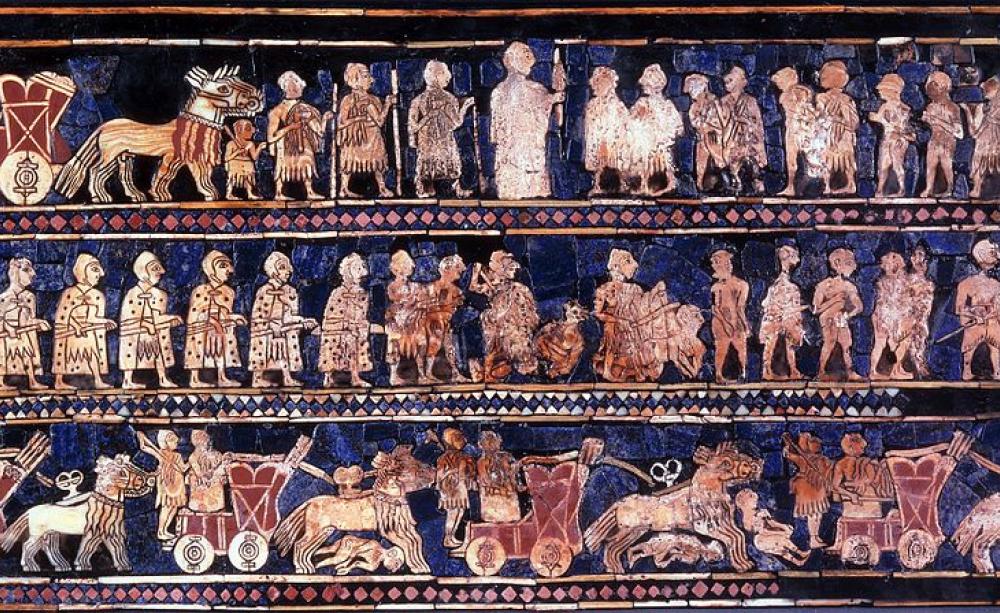
Fred Stein, 1944
“Another world is not only possible, she is on her way. On a quiet day, I can hear her breathing.” – Arundhati Roy
In the first two articles of this series, we alluded to a new strategic vision that is emerging across many different movements, through which we can achieve a genuinely democratic, egalitarian, and ecological society. In this next installment, we sketch this vision of a transition out of capitalism through grassroots organising to build the new world in the shell of the old.
If we want real change, should we draw up a sketch of a just society and then simply march towards it? We think it’s better to look around and find the seeds of a better future—perhaps dormant—in the present, and nurture them into a viable alternative that can challenge and transform the world around us.
Even as we carry the dream of ecological utopia in our hearts, our visions of the future cannot be divorced from the process by which they could realistically come about. To bring about lasting change, we need to identify, build up, and bring together existing utopias in the present, creating actual power in the places we live and work.
How power works
To build power, we need to understand how it works. The German-American political philosopher Hannah Arendt argued that intolerable situations such as ours can be cast aside by the public’s withdrawal of support from its governing institutions. While not a leftist, Arendt was a prominent theorist of totalitarianism, political violence, and direct democracy who developed important concepts that can help us chart a path forward.
Power is conventionally understood as the ability to make others do things, often through violence or coercion. In On Violence, however, Arendt argues that power works quite differently. She defines “power” as people’s ability to act in concert—the capacity for collective action, and thus a property of groups, not individuals. Leaders possess their power only because their constituents have empowered them to direct the group’s collective action.
Arendt asserts that all power, in every political system from dictatorships to participatory democracies, emerges from public support. No dictator can carry out his or her will without obedience from subjects; nor can any project requiring collective action be achieved without the support, begrudging or enthusiastic, of the group.
When people begin to withdraw their support and refuse to obey, a government may turn to violence, but even that control lasts only as long as the army or police choose to obey. “Where commands are no longer obeyed,” Arendt writes, “the means of violence are of no use… Everything depends on the power behind the violence.” Power, for the rulers as well as those who would resist them, comes through collective action, rather than force.
We cannot assume that overthrow of the current system will bring us a free and democratic new world, not without the preformation of the post-revolutionary society here in the present.
As a basis for a revolutionary political strategy, Arendt’s theory of power has several important limitations—limitations which we think can be overcome by focusing our efforts into organising real democratic institutions in communities where we live, in our everyday lives.
First, outside of rare moments of political crisis, the public has no way to collectively withdraw its support from governing institutions without preexisting mass organization. Individuals acting alone have no impact on the state’s power—we need the organisational capacity for greater mass action first.
Furthermore, most people will never even consider retracting support for governing institutions if they don’t experience viable alternatives. As Antonio Gramsci explained a century ago, the ruling class’s cultural hegemony—society’s domination by ruling class ideas—can be only undermined by what he called a “war of position”.
This means developing a material and cultural base within the working class to craft an oppositional narrative and to organise oppositional institutions. The organisation of unions, worker-owned firms, and housing cooperatives is what makes socialism a real, lived possibility around which greater movement-building can occur.
Lastly, we cannot assume that overthrow of the current system will bring us a free and democratic new world, not without the preformation of the post-revolutionary society here in the present. We need to actively create the institutions that will replace capitalism so that the transition we want can actually take place.
The transfer of authority to the structures of radical democracy requires the preexistence of such participatory institutions, not a naïve faith that they will be conjured into being out of a general strike, mass retraction of public support, or insurrectionary upheaval.
Incubating new institutions
So what can we do instead? An effective political strategy for the present would combine the best of Arendt’s intuitions about the workings of power in society and possibilities for popular revolution, with an organising vision of community institution-building.
With such dim prospects for sufficient progress through existing institutional channels, new democratic and cooperative institutions must be built from the ground up. These include structures for political democracy, such as neighborhood councils and assemblies, networked into grassroots confederations, and structures for economic democracy, such as housing cooperatives, worker-owned cooperatives, and community land trusts.
These new institutions should serve four fundamental purposes.
First, they can help us meet immediate human needs under conditions of deprivation and alienation. Amid a crumbling safety net and social atomisation in much of the industrialized world, new institutions of a cooperative economy can ensure that people are fed and sheltered, their human potential developed and their minds nourished, all while fostering the spirit of community and solidarity we so sorely need.
By meeting the needs of people in our communities, we can bring them into the movement. This way, we can reach everyone, including those most marginalised, and make it possible for them to participate in political struggle.
Second, such institutions can organize people for oppositional politics within the present system. Channeling popular power takes grassroots organising, which we can use to extract concessions from the state to improve our position for ever more transformative demands.
We can do this, for instance, through institutions like community councils and block associations that organise ordinary people neighborhood by neighborhood. When it is strategic, electoral campaigns may even emerge out of these organized communities. (We’ll discuss the thorny questions of electoralism in a later part of this series.)
Third, we can steadily erode public support for the institutions of the dominant society through the development and proliferation of viable alternatives. By growing a cooperative economy that provides for all, we can weaken our dependence on and steadily displace the capitalist economy.
By networking together institutions of genuinely democratic and participatory community governance, we can assemble a parallel political system that can challenge—and, in time, transform and replace—the various oligarchies of our day.
Fourth, this mosaic of community councils, cooperatives, land trusts, and more will form the institutional foundation of the liberated society. As hierarchical society gives way to genuine democracy, it is the institutions we organise and experiment with today that will become the replacements.
Dual power
What would this look like? We can adopt this four-pronged approach across multiple sites of struggle. In the workplace, workers can organise unions which challenge the absolute authority of the boss, win concessions to improve working conditions, and (more radically) take direct democratic control over the workplace through occupations or buy-outs to transition it to a cooperative.
In housing, tenants can organise tenant unions which can end landlord abuses through rent strikes, move towards tenant management and control over the building, and, with sufficiently resourced support, eventually aim to transition it into cooperatively owned social housing.
Organised workers and tenants can also leverage the power they built fighting bosses and landlords to change the rules of the game in the political arena and direct public resources into upscaling cooperative housing and worker ownership. And we can do this with the political system as a whole, through participatory democracy in our neighborhoods, networking together councils and assemblies as a new foundation of political authority.
This strategy is known as “dual power”. Murray Bookchin posited dual power as the creation of directly democratic and cooperative institutions that fortify each other, eventually challenging and replacing the legitimacy of the capitalist state.
The creation of these dual power institutions must grow out of people’s everyday experience and immediate needs—our needs for freedom from domination as well as for essential goods and services.
As Cornelius Castoriadis puts it: “Self-management will only be possible if people’s attitudes to social organisation alter radically. This, in turn, will only take place if social institutions become a meaningful part of their real daily life.”
By meeting basic community needs, such institutions rupture capitalism’s control over people’s lives, allowing oppressed people to carve out space within capitalism for economic democracy, defend it, and thus transform the world around them.
Beyond the local
But these initiatives must also be rooted in a strategy that transcends the local. Everywhere you look, there are examples of a different way of doing things: community gardens, food cooperatives, local currencies, strangers helping each other after a disaster.
They stand alone as individual projects, fine-tuned to solve local problems created by the current system’s failures. But when operating alone, they can’t create dual power. Without a wider unified base of support to network resources and share knowledge to sustain these alternatives, many just fizzle out over time.
The stakes are high: today, we’re faced with urgent threats of climate change, rising neo-fascism, and economic turmoil. Our challenge is to collect these quiet seeds of a new world, and plant them with care.
Every city has its graveyard of nonprofits, cooperatives, social clubs, and community centers. Without the more complex infrastructure of a whole solidarity economy ecosystem, our local projects cannot possibly amount to a systemic alternative to capitalism.
Individual cooperatives and mutual aid projects are not a transformative strategy in themselves, but should be understood as components of a larger project to assemble a new municipal commons under participatory democratic control.
By linking the local to regional, working together, sharing resources, and mutually reinforcing each other’s initiatives, communities can cultivate a creative and communal spirit that would empower them to take control of their lives, connect to one another across cultural and geographic distances, and develop the egalitarian foundations of a new society.
By confederating their local democratic councils into a powerful network, we can qualitatively change the power relations of a city or neighborhood and lay the groundwork for new macro-structures of self-governance and civil society.
In this series, we’ll talk in depth about some of these institutions: community land trusts, tenant rights organisations, workers’ cooperatives, unions, neighborhood councils, popular education projects.
These are not new inventions; they’ve been developed through generations of popular struggle all over the world. We’ll discuss how movements past and present have made use of them and what place we see for them within our broader revolutionary vision, to synthesize them into a unified anti-capitalist strategy at every level of society.
The stakes are high: today, we’re faced with urgent threats of climate change, rising neo-fascism, and economic turmoil. Our challenge is to collect these quiet seeds of a new world, and plant them with care.
These Authors
The Symbiosis Research Collective is a network of organizers and activist-researchers across North America, assembling a confederation of community organizations that can build a democratic and ecological society from the ground up. We are fighting for a better world by creating institutions of participatory democracy and the solidarity economy through community organizing, neighborhood by neighborhood, city by city. Twitter: @SymbiosisRev
This article was written by Mason Herson-Hord (@mason_h2), Aaron Vansintjan (@a_vansi), Jason Geils, and Katie Horvath (@katesville7).
